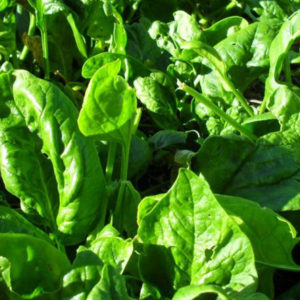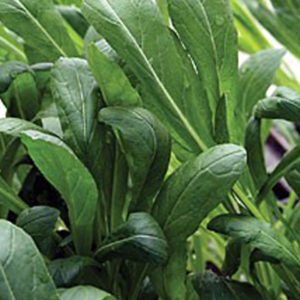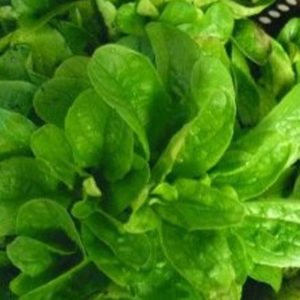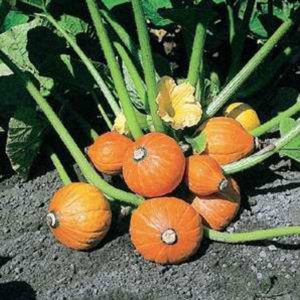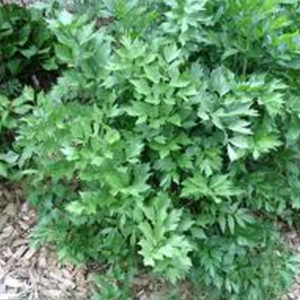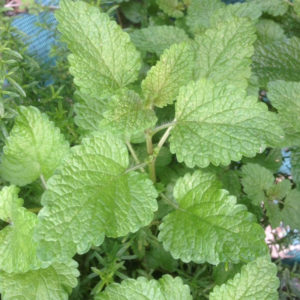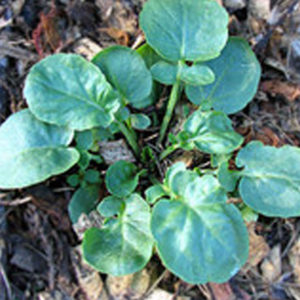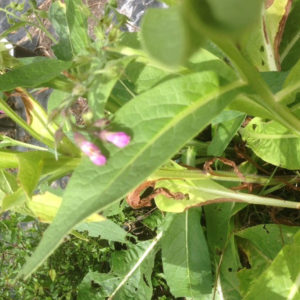-
 Lagenaria siceraria You’ll note by the unusual seed that this is not of the pumpkin or squash family and should be eaten when young like a zucchini. And it’s delicious by all the taste tests. Creamy with great texture. Growing conditions are much like the ‘squash’ Tromboccini and again watching these vigorous plants grow is a delight. Highly recommended and rare.
Lagenaria siceraria You’ll note by the unusual seed that this is not of the pumpkin or squash family and should be eaten when young like a zucchini. And it’s delicious by all the taste tests. Creamy with great texture. Growing conditions are much like the ‘squash’ Tromboccini and again watching these vigorous plants grow is a delight. Highly recommended and rare. -
 Barbarea verna Slightly hotter than watercress but a very similar flavour. Does not need water to grow. Often grown for it’s affective deterrent of white butterfly larvae which tend to eat the leaves even though it means their demise. Recommend planting throughout the garden when planting brassicas.
Barbarea verna Slightly hotter than watercress but a very similar flavour. Does not need water to grow. Often grown for it’s affective deterrent of white butterfly larvae which tend to eat the leaves even though it means their demise. Recommend planting throughout the garden when planting brassicas. -
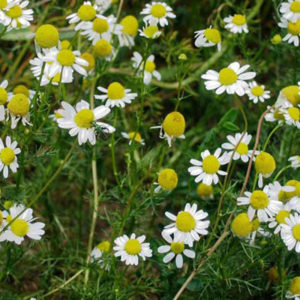 Matricaria recutita Daisylike flowers on this erect annual with green feathery leaves, looks great in any cottage garden. Chamomile flowers are used for a medicinal tea known amongst many things as a calmative and soothing on the stomach. Very fine dust like seeds can be broadcast in the garden or carefully planted on seed trays from Sept onwards when soil is warm. Seeds need light to germinate so sow on surface and water well.
Matricaria recutita Daisylike flowers on this erect annual with green feathery leaves, looks great in any cottage garden. Chamomile flowers are used for a medicinal tea known amongst many things as a calmative and soothing on the stomach. Very fine dust like seeds can be broadcast in the garden or carefully planted on seed trays from Sept onwards when soil is warm. Seeds need light to germinate so sow on surface and water well. -
 Artemisia absinthium Tall bush with dusty green feathery leaves wormwood is grown in cottage gardens as a beautiful backdrop to the more colourful flowers. Known as an effective wormer amongst its many medicinal qualities. Often grown just outside the pen so chickens can self medicate. Plant on surface of trays sparingly ( Wormwood needs light to germinate) & water till germination in 2-4 weeks. Transplant 70cm apart.
Artemisia absinthium Tall bush with dusty green feathery leaves wormwood is grown in cottage gardens as a beautiful backdrop to the more colourful flowers. Known as an effective wormer amongst its many medicinal qualities. Often grown just outside the pen so chickens can self medicate. Plant on surface of trays sparingly ( Wormwood needs light to germinate) & water till germination in 2-4 weeks. Transplant 70cm apart. -
Out of stock
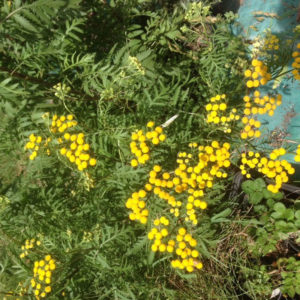 Tanacetum vulgare Herbaceous perennial flowering plant native to temperate Europe and Asia. Tall 100cm plant with segmented leaves and fernlike appearance. Then a display of golden flower heads. Many good medicinal qualities for external use including skin purifying and joint pain Tansy is not recommended for internal use except by physicians. Great insect repellent and often grown near entrances for this reason.
Tanacetum vulgare Herbaceous perennial flowering plant native to temperate Europe and Asia. Tall 100cm plant with segmented leaves and fernlike appearance. Then a display of golden flower heads. Many good medicinal qualities for external use including skin purifying and joint pain Tansy is not recommended for internal use except by physicians. Great insect repellent and often grown near entrances for this reason. -
Out of stock
 Pycnanthemum virginianum Herbaceous plant with strong spearmint smell and flavour when leaves are brushed against or crushed. Great in drinks or used moderately as flavouring in salads or coleslaws.
Pycnanthemum virginianum Herbaceous plant with strong spearmint smell and flavour when leaves are brushed against or crushed. Great in drinks or used moderately as flavouring in salads or coleslaws. -
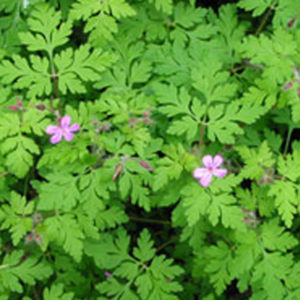 Geranium robertianum Of the Geranium family feathery leaves with pretty pink flowers this remarkable little annual will spread through your garden. And let it. "Herb Robert is a supreme, therapeutic herb. This herb’s action is one of the most outstanding herbs that we can use regularly, as an enhancer of the immune system. Research has revealed herb Robert is a source of germanium, a valuable element to the body, as it has the ability to make oxygen available to the cells. More oxygen, at cell level, means the body has the opportunity to fight disease by its own powers, and healing can take place quickly. Lack of oxygen, available to the cells, can be caused by free radicals and a toxic state around the cells: meaning the cells cannot get the required oxygen, or the nutrients, to regenerate." Quote Herbs are Special. Refer to Isabell Shiphard for more.
Geranium robertianum Of the Geranium family feathery leaves with pretty pink flowers this remarkable little annual will spread through your garden. And let it. "Herb Robert is a supreme, therapeutic herb. This herb’s action is one of the most outstanding herbs that we can use regularly, as an enhancer of the immune system. Research has revealed herb Robert is a source of germanium, a valuable element to the body, as it has the ability to make oxygen available to the cells. More oxygen, at cell level, means the body has the opportunity to fight disease by its own powers, and healing can take place quickly. Lack of oxygen, available to the cells, can be caused by free radicals and a toxic state around the cells: meaning the cells cannot get the required oxygen, or the nutrients, to regenerate." Quote Herbs are Special. Refer to Isabell Shiphard for more. -
Out of stock
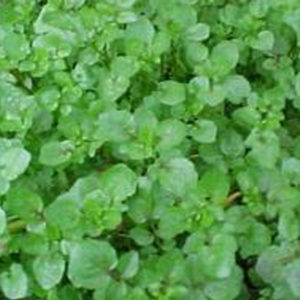 Slightly hot delicate leaf used in salads and Asian soups. Refreshing.
Slightly hot delicate leaf used in salads and Asian soups. Refreshing. -
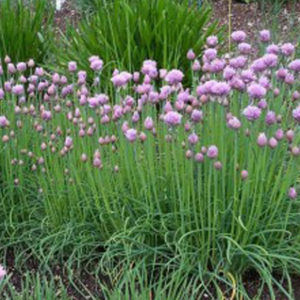 Allium schoenoprasum Perennial originating from Europe Asia & North America. 40cm tall hollow fine tubular stems from central bulb chives are generally dormant in winter and regrow and can be side picked the rest of the year. Often grown in pots, as borders and around gardens due to their insect repelling properties.
Allium schoenoprasum Perennial originating from Europe Asia & North America. 40cm tall hollow fine tubular stems from central bulb chives are generally dormant in winter and regrow and can be side picked the rest of the year. Often grown in pots, as borders and around gardens due to their insect repelling properties. -
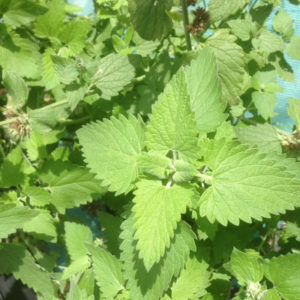 Nepeta cataria Growing to 100cm the soft green leaves with coarse-toothed edges have a slightly mint smell and is related. The flowers are thick, showy and great bee attractants. Catnip is seriously lovely by cats who rub against it enthusiastically. Has a long history of medicinal uses in the form of tea, juice, tinctures and poultices.
Nepeta cataria Growing to 100cm the soft green leaves with coarse-toothed edges have a slightly mint smell and is related. The flowers are thick, showy and great bee attractants. Catnip is seriously lovely by cats who rub against it enthusiastically. Has a long history of medicinal uses in the form of tea, juice, tinctures and poultices.




